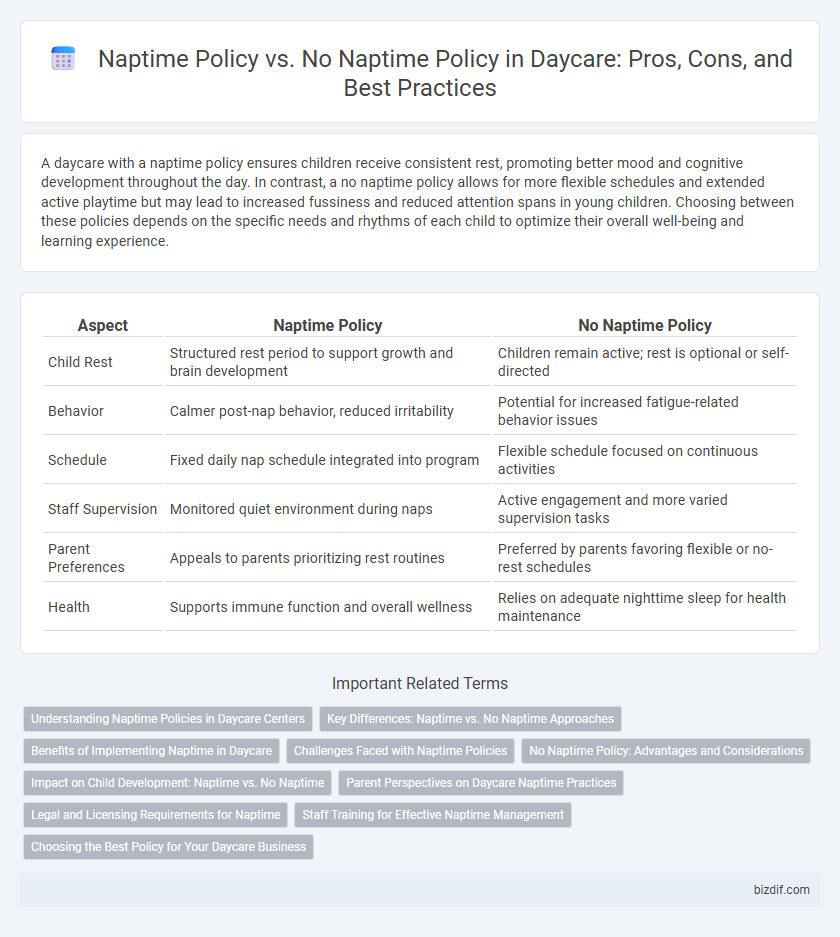A daycare with a naptime policy ensures children receive consistent rest, promoting better mood and cognitive development throughout the day. In contrast, a no naptime policy allows for more flexible schedules and extended active playtime but may lead to increased fussiness and reduced attention spans in young children. Choosing between these policies depends on the specific needs and rhythms of each child to optimize their overall well-being and learning experience.
Table of Comparison
| Aspect | Naptime Policy | No Naptime Policy |
|---|---|---|
| Child Rest | Structured rest period to support growth and brain development | Children remain active; rest is optional or self-directed |
| Behavior | Calmer post-nap behavior, reduced irritability | Potential for increased fatigue-related behavior issues |
| Schedule | Fixed daily nap schedule integrated into program | Flexible schedule focused on continuous activities |
| Staff Supervision | Monitored quiet environment during naps | Active engagement and more varied supervision tasks |
| Parent Preferences | Appeals to parents prioritizing rest routines | Preferred by parents favoring flexible or no-rest schedules |
| Health | Supports immune function and overall wellness | Relies on adequate nighttime sleep for health maintenance |
Understanding Naptime Policies in Daycare Centers
Daycare centers implement naptime policies to promote children's healthy development, ensuring adequate rest crucial for cognitive growth and emotional regulation. Facilities with no naptime policies often rely on alternative quiet activities to accommodate children who do not require sleep, balancing individual needs and group routines. Understanding these policies helps parents choose care environments aligned with their child's sleep patterns and developmental requirements.
Key Differences: Naptime vs. No Naptime Approaches
Naptime policies in daycare centers prioritize structured rest periods to support children's cognitive development, emotional regulation, and physical growth, promoting a calm environment that aids in reducing behavioral issues. In contrast, no naptime approaches emphasize continuous engagement and active learning, catering to older toddlers or children with less need for daytime sleep, often incorporating quiet time as an alternative to maintain balance. The key difference lies in balancing developmental needs with daily programming flexibility, where naptime fosters rest and recovery while no naptime encourages uninterrupted social and educational activities.
Benefits of Implementing Naptime in Daycare
Implementing a naptime policy in daycare significantly enhances children's cognitive development and emotional regulation by providing essential rest during critical growth periods. Studies show that scheduled naps improve attention span, memory consolidation, and reduce behavioral issues, fostering a more conducive learning environment. A structured naptime supports caregivers in maintaining routine consistency, which boosts overall daycare quality and parent satisfaction.
Challenges Faced with Naptime Policies
Naptime policies in daycare settings often face challenges such as difficulties accommodating individual sleep needs and managing diverse age groups with varying rest requirements. Strict nap schedules can lead to increased resistance and stress among children who do not conform to typical sleep patterns. Additionally, enforcing naptime can pose logistical issues for staff, impacting overall classroom management and child engagement.
No Naptime Policy: Advantages and Considerations
No naptime policies in daycare settings can promote extended activity periods that encourage social interaction and cognitive development among toddlers. This approach suits children with varied sleep needs and helps maintain consistent daily schedules without disruptions. However, caregivers should monitor for signs of fatigue and provide quiet time alternatives to support rest and prevent overtiredness.
Impact on Child Development: Naptime vs. No Naptime
Naptime policies in daycare significantly influence child development by promoting cognitive function, emotional regulation, and physical growth through adequate rest periods. In contrast, no naptime policies may lead to increased irritability, reduced attention span, and hindered memory consolidation in young children. Research consistently shows that structured naptime supports neural plasticity and overall behavioral health in early childhood.
Parent Perspectives on Daycare Naptime Practices
Parents supporting daycare naptime policies often cite improved child behavior and enhanced afternoon focus as key benefits, emphasizing the importance of scheduled rest for developmental health. Conversely, some parents oppose mandatory naptime, arguing it may disrupt natural sleep patterns and increase stress for children resistant to resting. Overall, parental perspectives on daycare naptime practices vary widely, influenced by individual child needs and family routines.
Legal and Licensing Requirements for Naptime
Daycare centers must comply with state-specific legal and licensing requirements regarding naptime policies, which often mandate designated rest periods to ensure child safety and wellbeing. Facilities without naptime policies may risk failing licensing inspections or facing penalties due to non-compliance with regulations set by childcare authorities. Regulatory guidelines typically specify the duration, supervision, and environment standards for naptime to promote healthy development and reduce liability.
Staff Training for Effective Naptime Management
Staff training in daycare centers with a naptime policy emphasizes recognizing children's sleep cues, creating a calm environment, and managing individual sleep needs to ensure restorative rest. In contrast, centers without a naptime policy train staff to engage children in quiet, structured activities that promote relaxation without sleep interruptions. Effective naptime management training enhances overall child well-being, behavioral regulation, and supports caregivers in maintaining a peaceful classroom atmosphere.
Choosing the Best Policy for Your Daycare Business
Choosing the best naptime policy for your daycare business depends on the developmental needs of children and parent preferences. Implementing a flexible naptime policy encourages individualized rest schedules, enhancing children's cognitive and emotional growth while accommodating diverse family routines. Evaluating child age groups, staff training, and space availability ensures the policy supports optimal child well-being and operational efficiency.
Naptime Policy vs No Naptime Policy Infographic

 bizdif.com
bizdif.com